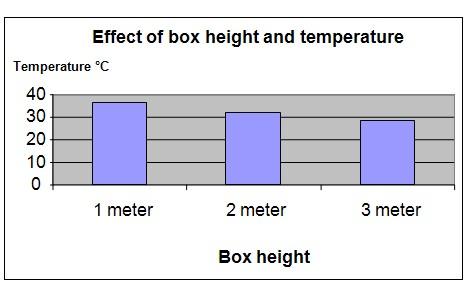| Complexity level: | 8 |
| Project cost ($): | 30 |
| Time required: | 1 hour to prepare, 1 day for the science project experiment |
| Material availability: | Easily found |
| Safety concerns: | Basic safety requirements. Handle electricity and hot lightbulbs with care and proper protection/gloves. |
Hypothesis
The higher the ceiling, the lower the room temperature.
Overview
Ceiling height and room temperatures
The temperature inside a room will normally increase due to heat sources within the room, and also due to heat from the sun being absorbed by the roof and the walls of the house. Proper air ventilation is required in homes to keep the temperature inside the rooms at comfortable levels.
Heat sources located within the house include cooking, electrical appliances and our own bodies. Air within the house that is warmed by these heat sources, will float upwards towards the ceiling (as it is less dense than cool air) and eventually escape through ventilation holes, while cool air flows in through the windows. Therefore the higher the ceiling, the further the warm air will move upwards and the cooler the lower parts of the home will be – at least in theory.
The heat from the sun is absorbed by the roof and the walls of the house. This heat will cause the attic and the ceiling to become hot. The ceiling will then become a source of heat and warm up the air around it. Therefore the higher the ceiling, the further it is from the living area and the lower the temperature of the living area will be.
Scientific Terms
Materials
The materials required for this science fair project:
- 27 pieces of cardboard, size 1m x 1m
- a measuring tape
- 3 incandescent lamps rated at 25W
- 3 thermometers
- 1 ruler
- 1 paper knife
- 1 roll of masking tape
Procedure
1. For this science fair project, the independent variable is the height of the box. The dependent variable is the temperature inside each box. This is determined by using the thermometer to measure the temperature. The constants (control variables) are the heat generated by the incandescent lamp, the footprint (occupied floor size) of each box and the position of the thermometer.
2. The cardboards are used to construct 3 boxes. The bottom of the boxes will be open.
a. The first box will be made using 5 sheets of cardboard and will be 1 meter tall,
b. The second box will be made using 9 sheets of cardboard and will be 2 meters tall, and
c. The third box will be made using 13 sheets of cardboard and will be 3 meters tall.
The cardboard sheets will be attached together with masking tape.
3. A total of 8 rectangular holes size 300mm x 50mm are cut out on the 4 sides of the boxes. The first 4 holes will be 300mm above the floor and the next 4 holes will be 300mm from the top of the box. See figure 1. .

4. A small hole is made on one of the sides of each box, 400mm from the floor and the thermometer is inserted 5cm inside the box.
5. The incandescent lamp is placed on the floor in the center of the box and lit up. Once the temperature of the thermometer has stabilized, it is recorded in the table below.


Results
It is observed that the higher the “ceiling” of the box, the lower the temperature recorded by the thermometer.
|
Box height |
Temperature °C |
|
1 meter |
36.5 |
|
2 meter |
32.0 |
|
3 meter |
28.5 |
The chart below represents the results of our science project experiment.

Conclusion
Our hypothesis has been proven to be true. The higher the ceiling, the lower the room temperature.
Houses with low ceiling are suitable for colder climates because they help to keep the house warm, whereas houses with higher ceilings are suitable for warmer climates because they provide better air ventilation and keep temperatures lower. However, rooms with higher ceiling will require more powerful air conditioning compared to the lower ceiling rooms, as the volume of air in the room will be greater.
Also consider
What would happen if the science fair project were to be repeated using lamps of different wattage?
The science fair project can be also repeated by making the floor space of the box bigger or smaller.
References
Attic ventilation for homes - http://www.factsfacts.com/MyHomeRepair/ventilation.htm
Ceiling height and cooling cost - http://www.newton.dep.anl.gov/askasci/eng99/eng99420.htm

